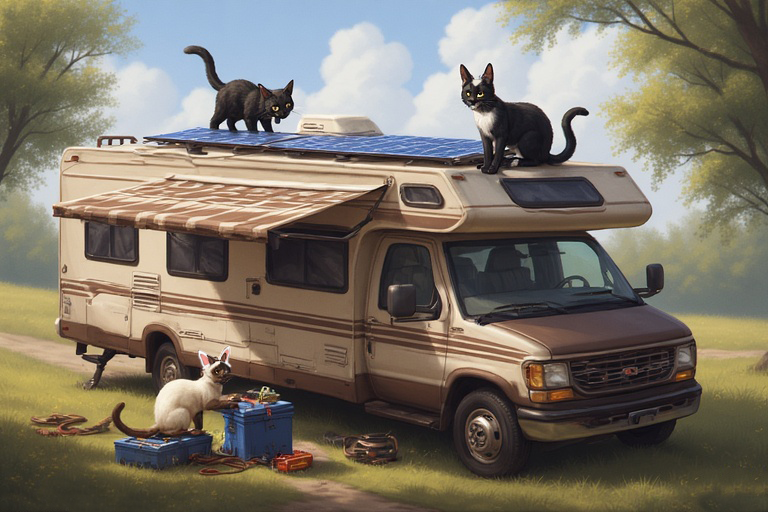I tasked Franklin with 2 main jobs in the remodel: figure out a solution for internet while on the road, and take care of the electrical stuff. My goal was to have an RV that I could boondock in, which means camp without any water, sewer, or electrical hookups at all. I wanted to be able to spend a day or two with a working refrigerator and air conditioner and the ability to charge all our devices and power laptops no matter where.
Most RVs come with a propane system that usually powers the fridge and stove, and a generator that covers everything else. Propane and gas for the generator are expensive, so I wanted to introduce solar power to the system. Plus, generators are loud and not always allowed in some boondocking spaces, like parking lots or rest stops. I preferred to rely on shore power (plugging into an outlet) first, then batteries if there was no electrical hookup, and then the generator as a last resort. Most people do it in reverse where the generator is the backup and the batteries are the backup to the backup, but I’d rather avoid using the generator at all if I can. Gennys are consumables and keep costing money. Solar, once the installation is paid for, is free.
So Franklin came up with a wiring plan that would charge the batteries both from the shore power and from the solar (one or the other, not both at the same time but I could choose) and a battery system that would cover all the devices. This included changing all the batteries to lithium LiFePO4 (a specific type of lithium-ion) instead of lead-acid. Franklin managed to find 4 batteries at half price and a good deal on a solar panel system.
While planning, Franklin consulted a member of the extended Squiggle who is also a full time RVer and who has extensive experience with solar panels. Daniel got so excited about the idea of designing and setting up a new solar panel system that he offered to hop on a plane and fly down to Florida as soon as possible!
First, the first solar panel that Franklin found turned out to be a house panel that was so big, it wouldn’t fit in my hatchback even with the seats down and it was too fragile to strap to the roof. So he went back to the drawing board, i.e. Amazon and found a system of multiple panels that not only would fit on the roof but also were designed to come off their racks and have a second set of racks installed on the side of the RV.
Solar panel placement actually depends on region, and a mobile home can cross into multiple regions. So it’s really important that the placement of the panels be flexible. Solar panels work best on the roof in southern states (in the US), closer to the equator, and they work best on the sides of an RV in northern states, assuming you can choose the direction that the RV faces. This system came with racks for both the roof and the sides, and the panels can be removed from the holding racks and placed in whichever location has the best exposure.
But then these solar panels got delayed! Daniel was already in town and could only stay for so long, but we had to wait as long as we had to wait. Not only did we have a deadline with Daniel leaving, but we also had another deadline – the launch date!
Originally, the plan was to find an RV, convert the electrical system to solar and lithium ion, do some light redecorating, and be on the road by Labor Day. That’s the weekend I always work DragonCon, a huge science-fiction convention in Atlanta. I figured we could drive up to DragonCon, I could work that weekend while boondocking in the RV in the parking lot outside the hotel, and then launch the cross-country road trip from there.
Unfortunately, we were nowhere near ready in time. Everything got delayed starting with finding an RV in the first place, and everything took way longer to accomplish than estimated. So my new goal was to just have the electrical and plumbing systems working and to use DragonCon as a test of those systems. I’ll get to the plumbing system later.
We literally worked on these systems right up until the moment we left for the convention. Daniel had to leave before we got the panels (although he helped so much with other things while we waited for them), so David stepped up and installed all the panels on the roof.
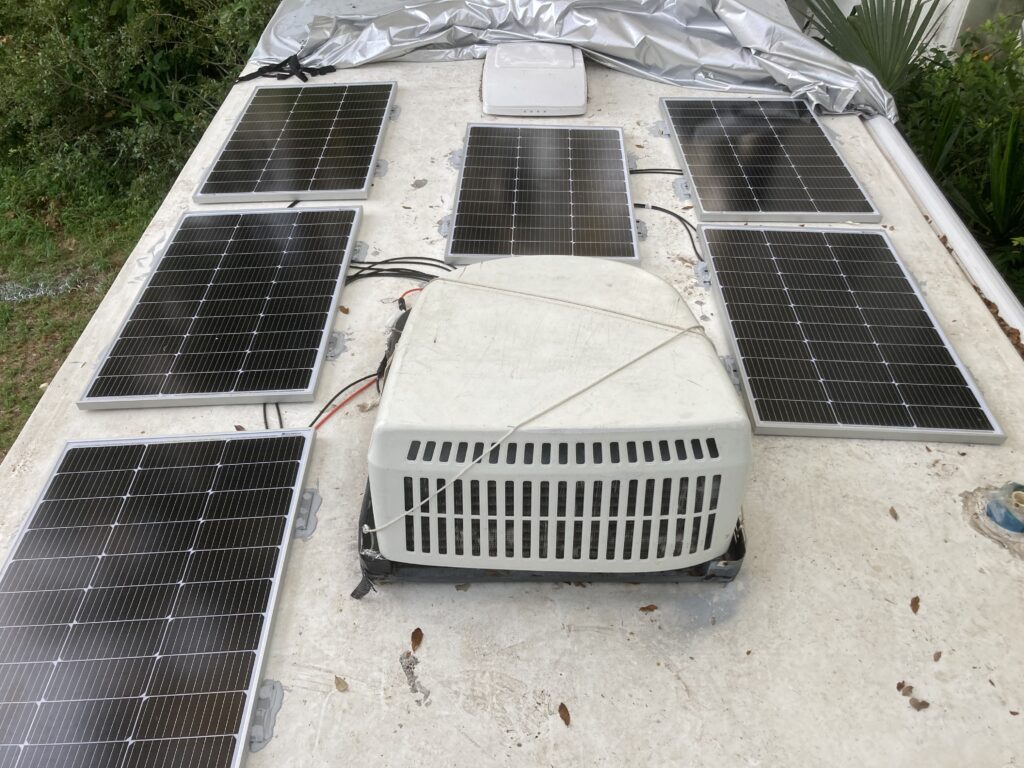
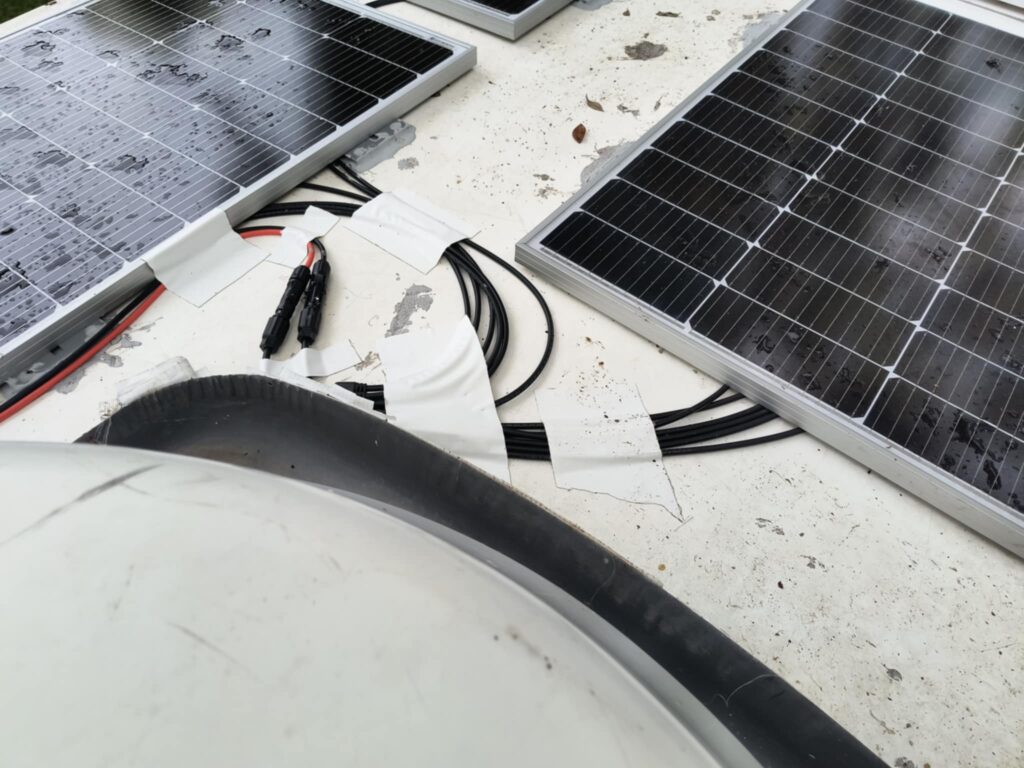
David was concerned about wind lifting the panels off the roof, so we looked up DIY videos of, essentially, solar panel “spoilers” – devices that divert airflow for better traction. The general consensus seemed to be that pretty much any material would work as long as it aimed the wind up and over the panels instead of underneath them.
We spent an afternoon wandering around Home Depot, looking for a material that was appropriate, cheap, and easy to cut and attach to the roof, while Franklin raided the plumbing section and looked for some electrical bits for the interior. After walking down every aisle, some more than once, I passed by the flooring aisle and remarked how the vinyl planks looked kind of exactly like what we were looking for.
Then I stopped and blinked. Wait a minute! I have more than a dozen boxes of vinyl flooring panels! I had already purchased the flooring material I intended to use because it was being discontinued so I grabbed it all before it was gone, at half-price. Plus, I still had a couple of boxes left over from when I used the same panels as wood paneling in my old RV (which I have now renamed The Void).
So I told David about it, and we decided to abandon our fruitless search and rejoin Franklin, so that David could attempt to MacGyver something out of my vinyl floor panels.
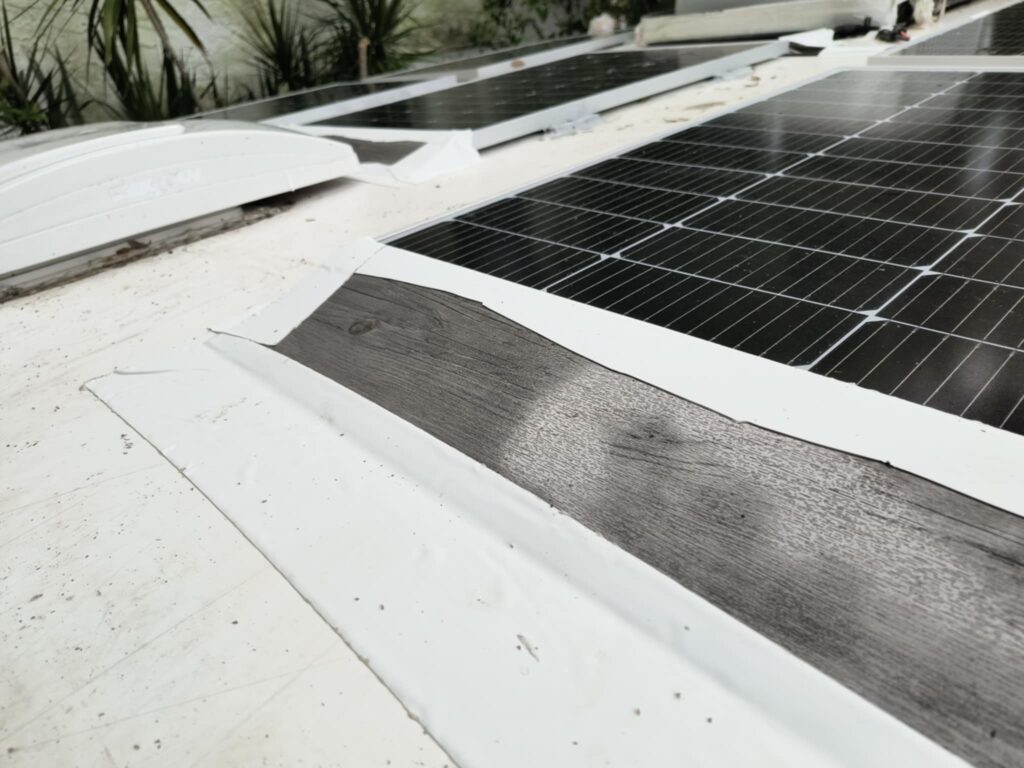
Using some super strong roof tape, David attached vinyl slabs cut to the width of the solar panels as a ramp from the roof to the top plane of the solar panel. This redirected the wind while driving to up and over the top of the panels, which actually pushes the panels back down onto the roof. David and I managed to get the last of the screw holes covered in lap sealant literally as the rain started to fall on the day before the trip. We threw the RV cover up over everything and moved inside to finish the work needed there. Which meant, of course, that we never had a chance to test the solar panels to see if they charged the batteries.
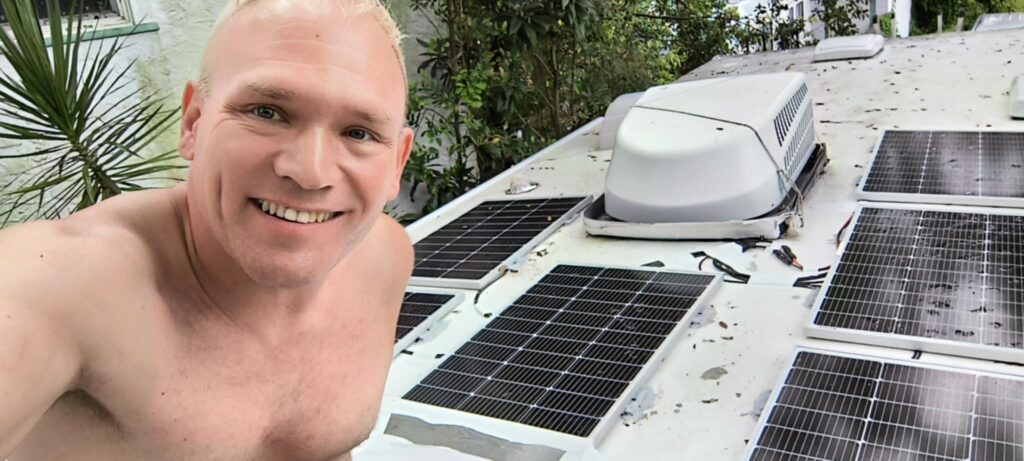
After a very hectic day of clearing the Transit out of everything possible that moved, we finally settled in for the night, expecting an early day of packing and prepping and traveling. Which is yet another story. But we eventually got on the road and headed to Atlanta for DragonCon with a mostly gutted RV and a half-working plumbing system and solar panels that we hadn’t tested to see if they would charge the batteries, nor batteries that we hadn’t tested to see if they would charge.
And THEN, only then when we were on the road, did Franklin mention to me in passing in response to something I had said, that none of the outlets on the RV were going to work! Why? Because there was no inverter anywhere in the system!
Um … why is there no inverter? I specifically requested an electrical system that would allow us to operate all normal electrical devices without hooking up to external power. I reiterated that several times – I wanted to be able to park in a field or the middle of the woods and be completely self-sufficient without any external assistance. A system where the batteries only powered the 12 volt devices (i.e. fridge, slide-outs, and installed ceiling lights of which there was only one) but none of the 110 electrical outlets did not meet that criteria!
Especially since a previous owner had ripped out all of the ceiling lights and replaced them all with LED strips that had to be plugged in. Without those outlets, not only could we not charge devices, we couldn’t run fans for cooling or electrical appliances for cooking (microwave, slow cooker, etc.), and we wouldn’t even have any lights after dark!
So Franklin found an inverter on Amazon that would meet our power usage needs and had overnight shipping and I ordered it sent to the hotel where I was working. Hopefully Franklin could put the inverter in line while David and I set up the conference on the first day we got into town and we would have a mostly comfortable rest of the week.
But such was not our luck! First, we discovered over the first two or three days that the batteries were not holding a charge through the night, even though they only thing they were powering was the fridge, 2 small fans for air flow (thank goodness it was an unseasonably cool Labor Day weekend this year!) and charging 3 phones. Second, the inverter got delayed by one day every single day until the final day! But it did eventually show up (during the tear-down for the conference), and I sent it out with Franklin to install it while David and I struck the show.
And eventually we figured out why the batteries weren’t holding a charge. This was a two-fold problem. One part was that there was a short in the system somewhere. We knew that before we left. Franklin had traced the short to somewhere in the ceiling, but he lost it once it left the walls so we didn’t know where, exactly, the short was to fix it. Everything else seemed to be working, so we ignored the short for the time being.
We also knew that the air conditioner wasn’t working, but we didn’t know why because we did not have enough amps back at the house to power an air conditioning unit so we could never test it to diagnose the problem. At the house, the RV was plugged into a standard house electrical outlet, and that’s just not enough power for a full sized RV air conditioning unit. It would need either a 30-amp outlet, or working 12-volt batteries. Once we had the batteries working, that would at least tell us if the problem was simply a matter of not enough power or something more complicated.
At some point, Franklin managed to discover 3 power circuits in an RV undercarriage compartment. He figured out that circuit #1 powered basically everything in the RV like lights and outlets, circuit #3 seemed to only power the slide-outs, and circuit #2 didn’t seem to power anything that he could see. Nothing died or lost power when he cut that circuit off. While brainstorming with Franklin about the battery charging problem, I wondered if the mystery short in the ceiling wasn’t a short in the air conditioner, and if circuit #2 powered that a/c unit, and if all of that might not be related to some of our power problems?
Well darned if that wasn’t it exactly!
The other part of the two-fold problem was a quirk of lithium ion batteries in parallel. Apparently, sometimes (but not always), when you buy a brand new lithium ion battery, it needs to be fully charged, even if it comes from the factory with a charge on it. BUT, it needs to be charged all by itself, not hooked up to any multi-battery system. We did not know that, so Franklin initially put all 4 of the new batteries in line and hooked them all up together to start charging.
This resulted in the first battery getting charged, but none of the others, and the charging sensor to record the first battery’s charge but not the others so it read that the charge was full when only the first batter was charged and the others were empty. So Franklin had to disconnect all the batteries and charge them one at a time using the solar panels (now that we were boondocking in a parking lot instead of plugged into a house), then reinstall them back in line to see what happened.
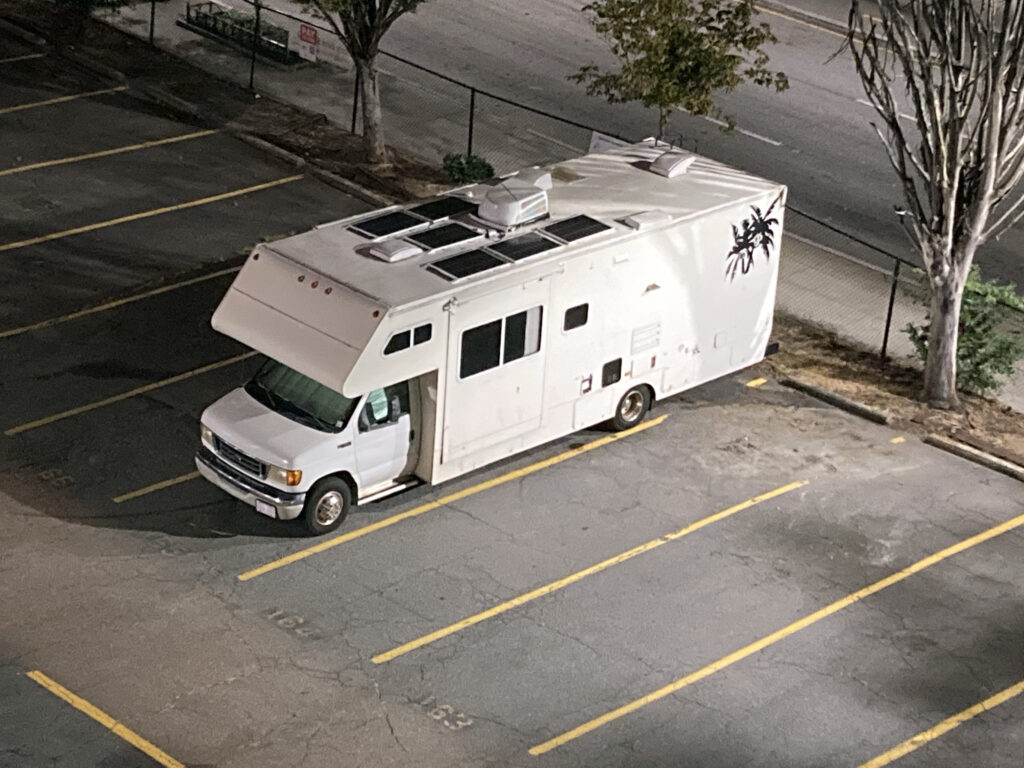
The combination of shutting off the circuit with a short in it and getting all of the batteries charged up (well, 3 of them, anyway – the 4th battery refused to charge but fortunately was under warranty, which I took care of back at home) finally solved our overnight power problem. We were no longer running out of juice halfway through the night with only 3 phones and a couple of fans running.
In fact, I accidentally discovered when we got home that these 3 batteries will run the fridge, a portable a/c unit, the lights, and random power tools for 10 whole days without any recharging! Getting the 4th battery replaced should have us with power for whatever length of time we need it while on the road, and at the very least keep us running overnight for one night with the fixed air conditioner running.
So, while nowhere near where I wanted to be in the schedule, we did have a successful test of the RV over Labor Day weekend in that the Transit made it to the destination and back in one piece and we discovered several problems in the plumbing and electrical systems and got them, if not completely fixed, at least identified and band-aid-solved for now.
The Transit now has 4 lithium ion batteries installed, and they can be charged from either shore power or solar power. An inverter has also been installed so that the fridge, lights, and all electrical outlets will work whether the Transit is plugged into an extension cord going into the house, an actual RV power outlet, or is using battery power. The solar panels are currently installed on the roof and seem to be working normally, although they mostly remain under the RV cover while parked at home and plugged into the house.
The circuit for the a/c unit has been shut off and a new a/c unit is on the way (that will be a project for another day … another month). All of this gives me regular-use power for more than a solid week before needing to either plug in or charge the batteries. And Franklin will be back next spring to clean up the hodge-podge mess of circuits and boards and large magic boxes into something more efficient now that he knows how it all works together and what I need from the system. Just in time to leave on our backup launch date!

